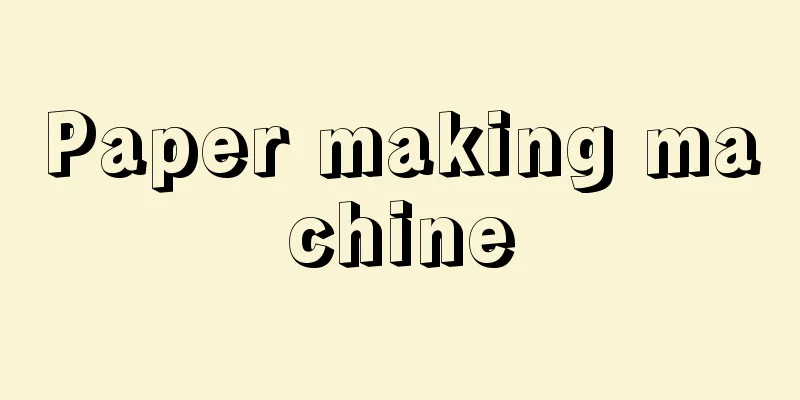Paper making machine

|
A machine for making paper. It consists of three main parts: the wet part, which strains the wet paper from the pulp suspension with a wire mesh, the press part, which presses the wet paper between rolls to squeeze out most of the water, and the dryer part, which dries it on a heated drum. The purpose of the invention of the papermaking machine was to mass-produce paper continuously, following the basic steps of papermaking, which had been done by hand. [Akio Mita April 18, 2016] History of the paper machineThe first papermaking machine invented was the Fourdrinier machine. In 1798, French engineer Nicolas Louis Robert (1761-1828) came up with the idea for today's Fourdrinier papermaking machine, and in the following year, 1799, he obtained a patent and created a model, but it was never put to practical use. This technology was purchased by paper mill owner St. Leger Didot (1767-1829) and others, who brought it to England, where it was improved with funds from the wealthy Fourdrinier brothers, Henry and Sealy Fourdrinier, and a practical machine was completed in 1808. For this reason, the Fourdrinier papermaking machine is still called the Fourdrinier machine today. The circular mesh papermaking machine was invented in 1809 by the British John Dickinson (1782-1869). It is interesting to note that the papermaking machines that are still the mainstay of papermaking factories around the world today were invented one after the other in such a short period of time. The invention of the papermaking machine thus dramatically increased paper production capacity, leading to a chronic shortage of raw pulp (non-wood pulp such as cotton rag pulp at the time). This was also the indirect cause of the simultaneous invention several decades later of various technologies for producing various pulps, including groundwood pulp, from wood. Following the technological change in the pulp industry after World War II, a new type of papermaking machine was born, which reminded us of a period of great change. There were a series of inventions that changed the conventional concept of papermaking machines, but the most significant was the invention of the twin-wire papermaking machine. Conventional papermaking machines used a wire that moved almost horizontally to separate wet paper from the pulp suspension, but this machine uses a pair of movable endless belt-like wires that are set upright, and the pulp suspension is passed between them, removing water from both sides to obtain wet paper. The twin-wire papermaking machine is vertical, so it requires less floor space than a fourdrinier papermaking machine, and the dryer section can be expanded, which increases paper production capacity. Larger twin-wire papermaking machines were developed and came to be operated as the largest papermaking facilities. The production capacity of a papermaking machine is expressed as the product of the width, speed (m/min), and paper basis weight (weight per area of paper, usually in grams per square meter). Therefore, in order to improve productivity, companies have made efforts to install larger papermaking machines to increase the papermaking width and speed, thereby increasing production volume and reducing production costs. Another invention that had a major impact on papermaking technology was the invention of plastic wire. The main part of the wet section of a papermaking machine is the mesh that forms the wet paper. It was once called wire because it was woven from bronze or stainless steel wire, but has since become a mesh woven mostly from plastic thread. Plastic wire has the advantages of having a lifespan three times longer than metal wire, being resistant to contamination, and being less likely to crease when replacing it with another wire. If the emergence of these new papermaking technologies leads to a renewed mass consumption of pulp and has a serious impact on the supply and demand of wood, the raw material, it is likely to prompt a major revolution in the traditional pulping technology that has been in use for over 100 years, and we can also expect to see a series of inventions that will revolutionize the production technology of recycled paper pulp and non-wood pulp. [Akio Mita April 18, 2016] Types of Paper MachinesThe first papermaking machine was the Fourdrinier papermaking machine, but various papermaking machines have been developed to meet various demands. The characteristics of papermaking machines are particularly evident in the difference between the wet and dryer sections. Generally, they are broadly classified into Fourdrinier papermaking machines, cylinder papermaking machines, Yankee machines, twin-wire papermaking machines, and others. [Akio Mita April 18, 2016] Fourdrinier paper machineThe wire part of the Fourdrinier papermaking machine is made of a long, wide wire that moves horizontally in the shape of an endless belt. A pulp suspension is poured onto it to filter out the pulp and form wet paper. The dryer part of the Fourdrinier papermaking machine consists of several dozen heated rotating drums. The wet paper is squeezed in the press part and dried in the dryer part to become the product. Fourdrinier papermaking machines are suitable for mass production, and the paper they produce has little unevenness in the papermaking process and little difference in strength between the length and width. As such, they were once widely used to manufacture various types of printing paper, such as newsprint, and various types of industrial paper, such as kraft paper for heavy-duty packaging. [Akio Mita April 18, 2016] Cylinder paper machineThe wire part of a cylinder papermaking machine consists of a tank for holding the pulp suspension and a cylinder with wires stretched over the surface of a cylindrical basket. When the cylinder is partially submerged in the pulp suspension in the tank and rotated, the pulp is filtered by the wires and a wet paper is formed on the outside of the cylinder. The formed wet paper is transferred to an endless blanket, squeezed in the press part, and dried in the dryer part, which consists of several dozen heatable rotating drums, to become the product. Paper made on a cylinder papermaking machine is particularly strong in the vertical direction, making it suitable for paper tape and paper string. In addition, the number of tanks in which the wet paper is formed can be increased to 2 to 8 tanks, and the raw pulp can be changed for each tank, so multiple wet papers sent from the wire part can be squeezed in the press part to form a single wet paper with a multi-layer structure. It is also widely used as it is suitable for the cheap mass production of multi-ply paperboard, as the outer layer can be made of virgin pulp and the inner layer can be made of inexpensive recycled pulp. [Akio Mita April 18, 2016] Yankee MachineA Yankee machine is a simple papermaking machine whose dryer section consists of a single large, heatable rotating drum. There are two types of Yankee machines: a cylindrical Yankee machine with a cylindrical wet section, and a short Yankee machine with a short, endless wire belt. Paper made with a short Yankee machine has less difference in strength between the length and width compared to paper made with a cylindrical Yankee machine. In addition, due to the structure of the machine, it is suitable for small-scale production of paper with a strong gloss on one side, and thin paper such as wrapping paper and slip paper used mainly in department stores. Machines equipped with a device for creping (shrinking) are called tissue machines, and are mainly used to manufacture cosmetic paper and toilet paper. [Akio Mita April 18, 2016] Twin Wire Paper MachineThe wire part of the twin-wire papermaking machine is characterized by the fact that a pulp suspension is passed between a pair of endless wires set up above and below, and the pulp suspension is filtered from both sides to form a wet paper. The press part and the dryer part are almost the same shape as those of the Fourdrinier papermaking machine. A papermaking machine that passes the pulp suspension from top to bottom is the Birch Homa, which is often used for making paperboard. Paper made with the Verbe Homa, which forms a wet paper by moving the pulp suspension from bottom to top along with the wires, is smoother than paper made with a Fourdrinier papermaking machine, has almost no difference between the front and back, and can be printed on both sides at high speed, so it is often used for mass production of newsprint and inexpensive printing paper. Most newsprint is made with a twin-wire papermaking machine or a Fourdrinier papermaking machine modified to a twin-wire papermaking machine. [Akio Mita April 18, 2016] Other paper machinesIn addition to these papermaking machines, there are combination machines in which the wire section of a papermaking machine has a cylinder and a fourdrinier to form wet paper, a set of press sections to squeeze water out of the wet paper, and a set of press sections to dry and make multi-layered paper. There are also papermaking machines that use several sets of fourdrinier or short wires instead of cylinders to produce paperboard that is strong and has little difference in strength lengthwise and widthwise, and squeeze the wet paper into a single sheet of paperboard and dry it. There are also multi-layer headboxes that use multiple types of pulp and can form wet paper using only one wire section. This method involves pouring a suspension of several types of pulp into the wire in layers, which has the advantage of requiring only one set of wires, but the layers tend to mix together, so when making white paperboard using recycled pulp from waste paper and white virgin pulp, for example, a large amount of virgin pulp needs to be placed on top. [Akio Mita April 18, 2016] "Paper and Pulp Technology Handbook" (1992), edited and published by the Paper and Pulp Technology Association; "Paper and Pulp Manufacturing Technology Series 6: Paper Making" (1998), edited and published by the Paper and Pulp Technology Association ; "Latest Technological Trends in Paperboard Machines" by Mitsufumi Matsumoto (published in the January 1998 issue of Paper and Pulp Technology Times, Shigyo Times Co., Ltd.) ; "Ancient Papermaking History and Technology" by Dard Hunter, translated by Yasuo Kume (2009, Bensei Publishing) [Reference items] | | | | | | |Source: Shogakukan Encyclopedia Nipponica About Encyclopedia Nipponica Information | Legend |
|
紙を抄(す)く機械。金網(ワイヤ)でパルプの懸濁液(けんだくえき)から湿紙を漉(こ)し取るウェットパート、おもにロールの間で湿紙をプレスして水分の大半を絞り取るプレスパート、加熱したドラム上で乾燥するドライヤーパートの三つの主要部分からなる。抄紙機の発明の目的は、手漉(す)きで行われていたものを、製紙の基本的な工程に沿って、連続的に大量生産することであった。 [御田昭雄 2016年4月18日] 抄紙機の歴史最初に発明された抄紙機は長網(ながあみ)抄紙機である。1798年、フランスの技術者ロベールNicolas Louis Robert(1761―1828)は今日の長網抄紙機を考え出し、翌1799年には特許を取得、模型も創作したが、実用化には至らなかった。この技術は製紙工場の経営者サン・レジェ・ディドーSt. Leger Didot(1767―1829)らに買い取られてイギリスに渡り、富豪フォードリニア兄弟Henry and Sealy Fourdrinierの資金により改良され1808年実用機が完成した。そのため今日でも長網抄紙機はフォードリニアマシンともよばれる。円網(まるあみ)抄紙機はイギリスのジョン・ディキンソンJohn Dickinson(1782―1869)によって1809年に発明された。このように、今日でも世界中の製紙工場で主力となっている抄紙機がきわめて短い期間に相次いで発明されたことは興味深いことである。 こうして抄紙機の発明は紙の生産能力を飛躍的に高めることとなった。そのため原料パルプ(当時は綿ぼろパルプ等の非木材パルプ)の不足は慢性化した。それが数十年後、木材から砕木パルプをはじめとする多くのパルプを製造する技術が一斉に発明される遠因ともなった。 第二次世界大戦後、パルプ工業におきた技術変革に続いて、一大変革期を思わせる新しい形式の抄紙機が生まれた。従来の抄紙機の概念を変える発明が相次いだが、もっとも大きいものはツインワイヤ方式の抄紙機の発明である。これは、従来の抄紙機が網をほぼ水平に動かしながらパルプの懸濁液から湿紙を抄き取っていたのに対して、可動の無端ベルト状にしたワイヤ2枚を1対にして立て、その間にパルプの懸濁液を流して、両面から水を抜き取り湿紙を得るという構造である。ツインワイヤ方式は縦型なので長網抄紙機に比べ床面積が狭くてすみ、ドライヤーパートを広げられるため紙の生産能力をあげることができる。このツインワイヤ抄紙機は大型機の開発が進み、最大規模の抄紙設備として稼動するようになった。抄紙機の生産能力は抄幅と抄速(m/分)と紙の坪量(つぼりょう)(紙の面積当りの重量、通常1平方メートル当りのグラム数)の積で表される。したがって各社は生産性をあげるために、大型の抄紙機を設備して抄幅を広げ、抄紙スピードをあげて生産量を増やし、生産コストを引き下げることに努力が払われてきた。 さらに製紙技術に大きな影響を与えたものとしては、プラスチックワイヤの発明があげられる。抄紙機のウェットパートの主要部分は湿紙を形成させる網であり、かつてはブロンズ(青銅)またはステンレス製の針金で織っていたのでワイヤとよばれていたが、その後はほとんどプラスチック製の糸で織られた網になった。プラスチックワイヤは金属ワイヤに比べ寿命が約3倍も長く、汚染に強く、他のワイヤと交換の際折れ目がつきにくいなどの利点がある。 これらの新しい抄紙技術の登場がふたたびパルプの大量消費をよび、原料となる木材の需給に深刻な影響を与えれば、これまで100年以上続いた従来のパルプ化技術に大きな変革を促すとともに、古紙パルプおよび非木材パルプの製造技術革命を促す発明が続出することも予想される。 [御田昭雄 2016年4月18日] 抄紙機の種類抄紙機として初めて世に出たのは長網抄紙機であったが、種々の要求にこたえてさまざまな抄紙機が生まれた。抄紙機の特徴はとくにウェットパートとドライヤーパートの違いに表れる。一般には長網抄紙機、円網抄紙機、ヤンキーマシン、ツインワイヤ抄紙機その他に大別される。 [御田昭雄 2016年4月18日] 長網抄紙機長網抄紙機のワイヤパートは、幅広の長いワイヤを無端ベルト状にして水平に動くようにできている。その上にパルプの懸濁液を流してパルプを漉し取り、湿紙を形成させる。長網抄紙機のドライヤーパートは、数十本の加熱された回転ドラムからなる。湿紙はプレスパートで絞られ、ドライヤーパートで乾燥され製品となる。長網抄紙機は大量生産向きで、得られる紙は抄きむらが少なく縦横の強度差が少ないため、かつては新聞用紙等各種印刷用紙、重包装用クラフト紙等各種産業用紙の製造に広く用いられていた。 [御田昭雄 2016年4月18日] 円網抄紙機円網抄紙機のワイヤパートは、パルプ懸濁液を入れる槽と円筒状の籠(かご)の表にワイヤを張った円網とからなり、円網の一部を槽のパルプ懸濁液に一部沈めて回転させると、ワイヤでパルプは漉されて湿紙が円網の外側に形成される。形成された湿紙は無端状につないだ毛布に移されプレスパートで絞られて、数十本の加熱可能な回転ドラムからなるドライヤーパートで乾燥され製品となる。円網抄紙機で抄かれる紙の強度は縦方向にとくに大きく、紙テープや紙紐(かみひも)用に適している。また円網抄紙機では湿紙を形成させる槽を2~8槽程度に増やすことや、原料パルプを各槽でかえることが可能なため、ワイヤパートから送られた複数の湿紙をプレスパートで絞って1枚の多層構造をもった湿紙にすることができる。また外側の層にはバージンパルプを、内側の層には安価な再生パルプを使うこともできるので、多層抄きの板紙を安く大量生産するのに向くとして広く使われている。 [御田昭雄 2016年4月18日] ヤンキーマシンヤンキーマシンは、ドライヤーパートが1本の大きな加熱可能な回転ドラムで構成される簡易な抄紙機で、ウェットパートが円網の円網ヤンキーマシンと、短い無端ベルト状のワイヤからなる短網ヤンキーマシンとがある。短網ヤンキーマシンで抄造される紙は円網ヤンキーマシンで抄造される紙に比べて縦横の強度差が少ない。また機械の構造から片面に強い光沢のある紙、おもにデパートなどで使われる包装紙や伝票用紙などの薄葉紙(うすようし)を少量生産するのに適する。またクレープ(縮み)をつける装置を有するものをティシュマシンといい、おもに化粧紙やトイレットペーパーの製造に用いる。 [御田昭雄 2016年4月18日] ツインワイヤ抄紙機ツインワイヤ抄紙機のワイヤパートは、上下に立てた一対の無端のワイヤの間にパルプの懸濁液を流して、両面から漉すことによって湿紙を形成させることを特徴としている。プレスパー卜とドライヤーパー卜は長網抄紙機とほとんど同形である。パルプの懸濁液を上から下に流す方式の抄紙機としては、バーチホーマがあり、板紙の抄造に多く使われる。パルプの懸濁液をワイヤとともに下から上に動かしながら湿紙を形成させる方式であるベルベホーマで抄いた紙は、長網抄紙機で抄造した紙に比べて平滑で、表裏の差がほとんどなく、高速で両面印刷が可能であるので、新聞用紙や安価な印刷用紙の大量生産に多く使われる。新聞用紙のほとんどは、ツインワイヤ抄紙機か、長網抄紙機をツインワイヤ抄紙機に改造したもので製造されている。 [御田昭雄 2016年4月18日] その他の抄紙機これらの抄紙機のほかに、1台の抄紙機のワイヤパートに円網と長網を有してそれぞれ湿紙を形成させ、一組のプレスパートで水を絞って1枚の湿紙にし、ドライヤーパートに送って乾燥し多層紙にするコンビネーションマシンがある。また強度があり、かつ縦横の強度差の少ない板紙を抄造するため、円網のかわりに幾組もの長網または短網で湿紙を抄きだし、一組のプレスパートで絞って1枚の板紙にして乾燥する方式の抄紙機がある。また多種類のパルプを用い、一つのワイヤパートだけで湿紙の形成を可能とするマルチレイヤヘッドボックスがある。これは数種のパルプの懸濁液を層状にしてワイヤに流し込む方式で、ワイヤが一組ですむ利点があるが、層間がお互いに混ざり合いやすいので、たとえば古紙の再生パルプと白いバージンパルプで白い板紙を抄造する場合に、上に乗せるバージンパルプの必要量が多くなるという欠点がある。 [御田昭雄 2016年4月18日] 『紙パルプ技術協会編・刊『紙パルプ技術便覧』(1992)』▽『紙パルプ技術協会編・刊『紙パルプ製造技術シリーズ6 紙の抄造』(1998)』▽『松本光史著「板紙マシンの最新技術動向」(『紙パルプ技術タイムス』1998年1月号所収・紙業タイムス社)』▽『ダード・ハンター著、久米康生訳『古代製紙の歴史と技術』(2009・勉誠出版)』 [参照項目] | | | | | | |出典 小学館 日本大百科全書(ニッポニカ)日本大百科全書(ニッポニカ)について 情報 | 凡例 |
Recommend
Historical drama
Also called a historical drama. A drama based on h...
Takada
[1] [Noun] Rice fields built on high ground. In an...
kamuy-yukar (English spelling) kamuyyukar
...However, yukar originally referred to the &quo...
Teacher's license - Kyoinmenkyo
A type of qualification system for school teacher...
Synthetic paper
A sheet-like material made primarily from synthet...
Kanra [town] - Kanra
A town in Kanra County in the southwest of Gunma P...
Nosema
...The malaria parasite Plasmodium is transmitted...
Sanemori Saito - Sanemori Saito
A warrior from the end of the Heian period. A des...
Soup - Soup
It is one of the four important pillars of Japane...
Kiriath-arba (English spelling) Kiriatharba
…A town that has existed since the 18th century B...
Regression - Regression
This refers to the movement of animals back to th...
Abū Muslim
?‐755 Leader of the Abbasid revolution in Khorasan...
mouse-ear cress
…It is widely distributed in Asia, Europe, and Af...
Kui
...South Dravidian includes Tamil (45 million spe...
Ohara school
It is one of the three major schools of ikebana, ...









